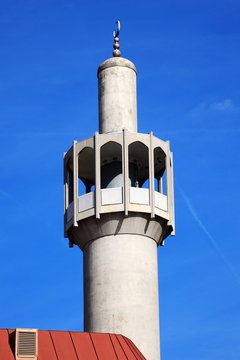Egungun is a most celebrated festival in the historical city of Ogbomoso in Oyo state, Nigeria. Celebration of Egungun festival in Ogbomoso has been in existence since year immemorial; its commencement period can’t be at all traced to any year in order not to get the history distorted, since there is no record to substantiate it. This festival is mostly observed by the traditionalists and other lovers of tradition, Christians and Muslims alike.
Meanwhile, traditionalists keenly argue or contest the fact that ‘egúngún’ shouldn’t be referred to as a ‘masquerade’ that, they have no correlation. Literally, masquerade (noun as a part of speech) refers to “a party or assembly of people wearing masks and amusing themselves with dancing, conversation or other diversions” and it also can be defined as “a dramatic performance by actors in masks or acting under false pretenses; concealment of something by a false or unreal show”. These definitions are not suitable to be referred to as “Egungun” as its meaning, according to traditional belief, is far beyond covering of face for amusement but the descending of spirit beings (ará òrun) to the earth to stage a visit to their people and worshippers in order to rain prayers on them. The crux of this paragraph is to erase the fallacious thought of some people that ‘egungun’ can be translated in English language to ‘masquerade’.
There are various genres of egungun, this is grouped according to their physical appearance, they are; egúngún elérù, egúngún òrèbé, egúngún aláte, egúngún alágò among others. Egúngún Alágò in Yoruba land, specifically Ogbomoso is common in the royal lineage as it is used to symbolize or represent kings that had transited to glory.
Egungun worshippers are referred to as ‘Eleegun or Oloje’ and the place the spirit being normally comes out is called ‘igbale’, a sacred place, where females must not gain entrance to, so that the secret will remain veiled.
There are various Egúngúns in Ogbomoso, the name of the compound always determines the name of the Egúngún. Some of them are Olukotun (the first to display) Dánáfojúrà, Ajókòómógbòódó, Lènbe, Alápàlà, Kìn-n-dín, Lóbaníkà, Adífálà, Dosù, Akáláifá, Ko-n-gbá, Mátèé, Omo- tuntun, Àwòdágbèsè etc. It is symbolic to state that each of them has special, peculiar attributes. As an instance, Dánáfojúrà baths itself in fire; Ajókòómógbòódón on its own sits comfortably without a seat etc
In Yoruba mythology, it is said, “Egungun Olu Ile Ife ti n san moriwo pako”. Egungun festival is celebrated in Ogbomoso in the seventh month of the year (July), during the rainy season. It used to be celebrated within the period of a week before it was extended to one and a half weeks in the early 70s. During the festival, Ogbomoso indigenes, both Christians and Muslims, old and young join in the celebration especially in the past, people in the Diaspora also do come home to witness this august celebration or festival in order to add to their knowledge and witness a custom and tradition of the famous town.

The spirit beings will be escorted by many people particularly people belonging to the family, each directed by its ‘Oloko’, and accompanied by drummers who conjure the cognomen of the particular Egungun. A day to the appearance of an Egungun, merriment and festivities would have been held with many people invited.

The Egungun itinerary consists of residences of some family members outside the main family compounds and other receptive acquaintances; they will pray for their hosts, perform special dances and their hosts in turn offer them gifts.
Okelerin is the rendezvous of the Egunguns. Most Egunguns will lead their processions through this neighbourhood that will become filled up with ecstatic people in the evening. Beating each other with atori cane by unmasked people characterizes the display here. In the past there were baby Egunguns known as kunduke. Kundukes were unadorned with charms and fetish objects unlike the genres listed above, they rather clutched atori, scrambled along alone or in groups and were active participants in atori beatings. At the approach of an Eegun Eleru however they all scamper into safety.






Also, at Okelerin, fracas ensues especially when two Egunguns meet, often arising from battle of supremacy i. e. no egungun will want to bow for the other. This often results in deadly confrontations in which the rival Egunguns freely use charms and mutter incantations against one another. This is always an interesting episode. Drummers are known to trigger many of such face offs with their unusual battlecry tunes.
However, Christianity and Islam religions and increasing civilization have taken their tolls on Egungun festival. Many olojes have jettisoned the tradition. Another factor constituting a hemlock to the festival is the increasing violence being associated with it wherein some young boys and men consciously unleash mayhem on followers of Egunguns. Dangerous weapons are freely used during such orgies. Turning this festival into a fratricidal warfare is, as a consequence, becoming a death trap for the once ebullient fiesta. These suicidal engagements are transforming the festival into something else and is rubbing the glamour off it. Many people who come to witness the annual festival have been disappointed by this show of violence and thuggery. This is something that must be looked into.
Conclusively, let’s educate and reorient the youths of this technological epoch to rekindle the glory of the festival by making it violent free, desist from heinous vandalization of property and gruesome wounding of people during the celebrations.

The justification for this assertion can be extracted or derived from the holy corpus of Ogbegunda that states the bad consequence of violence in the society and how it’s detrimental to peaceful living.
All lovers of Egungun, and Yoruba culture enthusiasts generally need to make conscious effort to reinvent the festival so that the enveloping malodorous occurrences will be extirpated thereby restoring its glory.

